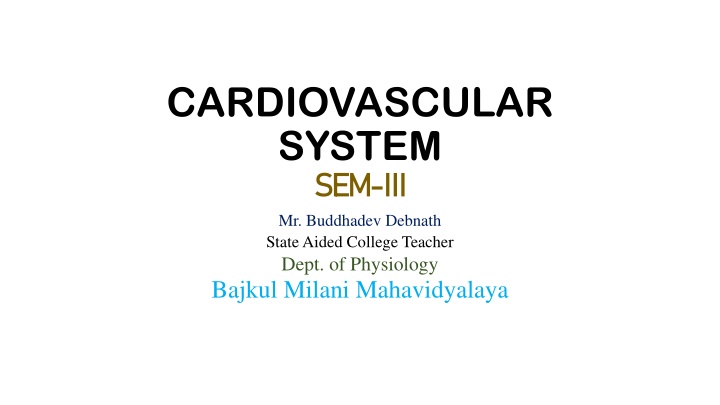
The Cardiac Cycle and Blood Pressure Variations
Explore the intricacies of the cardiac cycle, blood pressure variations, and the significance of ventricular function in maintaining cardiovascular health. Discover how atrial and ventricular contractions contribute to a healthy heartbeat, and learn about factors affecting blood pressure in a physiological context.
Download Presentation

Please find below an Image/Link to download the presentation.
The content on the website is provided AS IS for your information and personal use only. It may not be sold, licensed, or shared on other websites without obtaining consent from the author. If you encounter any issues during the download, it is possible that the publisher has removed the file from their server.
You are allowed to download the files provided on this website for personal or commercial use, subject to the condition that they are used lawfully. All files are the property of their respective owners.
The content on the website is provided AS IS for your information and personal use only. It may not be sold, licensed, or shared on other websites without obtaining consent from the author.
E N D
Presentation Transcript
CARDIOVASCULAR SYSTEM SEM-III Mr. Buddhadev Debnath State Aided College Teacher Dept. of Physiology Bajkul Milani Mahavidyalaya
Blood Pressure Normal BP varies by age, but is approximately 120 mm Hg systolic over 80 mmHg diastolic in a healthy young adult ( in females, the pressures are often 8 10 mm Hg less.) People who are in good physical condition or who have a favorable genetic predisposition have lower BPs. It is often best to refer to the blood pressure as a single number, called the mean arterial pressure (MAP) . MAP is roughly 1/3 of the way between the diastolic and systolic BP. It is defined as 1/3 (systolic BP diastolic BP) + diastolic BP.
Blood Pressure In a person with a BP of 120/80 mm Hg, MAP = 1/3 (120-80) + 80 = 93.3 mm Hg. In the smaller arterioles, capillaries, and veins, the BP pulsations are not detectable, and only a mean BP is measurable (see the purple and blue areas of this figure).
Cardiac Cycle The cardiac cycle includes all events associated with one heartbeat, including diastole (relaxation phase) and systole (contraction phase) of both the atria and the ventricles. In each cycle, atria and ventricles alternately contract and relax. During atrial systole, the ventricles are relaxed. During ventricle systole, the atria are relaxed.
Cardiac Cycle Since ventricular function matters most to the body, the two principal events of the cycle for us to understand are ventricular filling (during ventricular diastole), and ventricular ejection (during ventricular systole). The blood pressure that we measure in the arm is a reflection of the pressure developed by the left ventricle, before and after left ventricular systole. Pulmonary blood pressure is a result of right ventricular function, but is not easily measured.
Cardiac Cycle The sequence of events in one cardiac cycle is shown in Figure 20.14. Pay particular attention to the left ventricle: 1st is atrial systole Followed by atrial diastole and ventricular systole Finally, ventricular diastole
Cardiac Cycle Valves AV SL Outflow Atrial systole Ventricular diastole Open Closed Ventricular systole Early atrial diastole Closed Open Ventricular diastole Late atrial diastole Open Closed
Cardiac Cycle During the cardiac cycle, all 4 of the heart valves have a chance to open and close. Listening (usually with a stethoscope) to the sounds the heart makes is called auscultation. Valve opening is usually silent. The lubb dupp we associate with heart auscultation is produced by valve closure (in pairs see p. 740 left side).
Cardiac Cycle The average time required to complete the cardiac cycle is usually less than one second (about 0.8 seconds at a heart rate of 75 beats/minute). 0.1 seconds atria contract (atrial kick ), ventricles are relaxed 0.3 seconds atria relax, ventricles contract 0.4 seconds relaxation period for all chambers, allowing passive filling. When heart rate increases, it s this relaxation period that decreases the most.
Cardiac Cycle (Interactions Animation) Cardiac Cycle You must be connected to the internet to run this animation
Cardiac Output The stroke volume (SV) is the volume of blood ejected from the left (or right) ventricle every beat. The cardiac output (CO) is the SV x heart rate (HR). In a resting male, CO = 70mL/beat x 75 beats/min = 5.25L/min. On average, a person s entire blood volume flows through the pulmonary and systemic circuits each minute.
Cardiac Output The cardiac reserve is the difference between the CO at rest and the maximum CO the heart can generate. Average cardiac reserve is 4-5 times resting value. Exercise draws upon the cardiac reserve to meet the body s increased physiological demands and maintain homeostasis.
Cardiac Output The cardiac output is affected by changes in SV, heart rate, or both. There are 3 important factors that affect SV (p. 741): The amount of ventricular filling before contraction (called the preload) The contractility of the ventricle The resistance in the blood vessels (aorta) or valves (aortic valve, when damaged) the heart is pumping into (called the afterload)
Cardiac Output The more the heart muscle is stretched (filled) before contraction (preload), the more forcefully the heart will contract. This phenomenon is known as Starling s Law of the heart. Stimulation of the sympathetic nervous system during exercise increases venous return, stretches the heart muscle, and increases CO.
Cardiac Output (Interactions Animation) Cardiac Output You must be connected to the internet to run this animation
